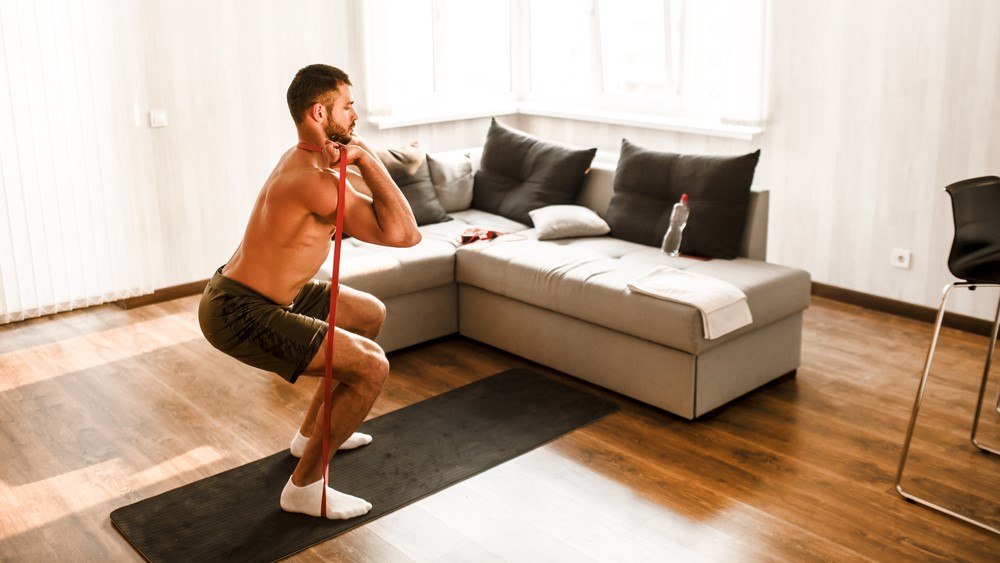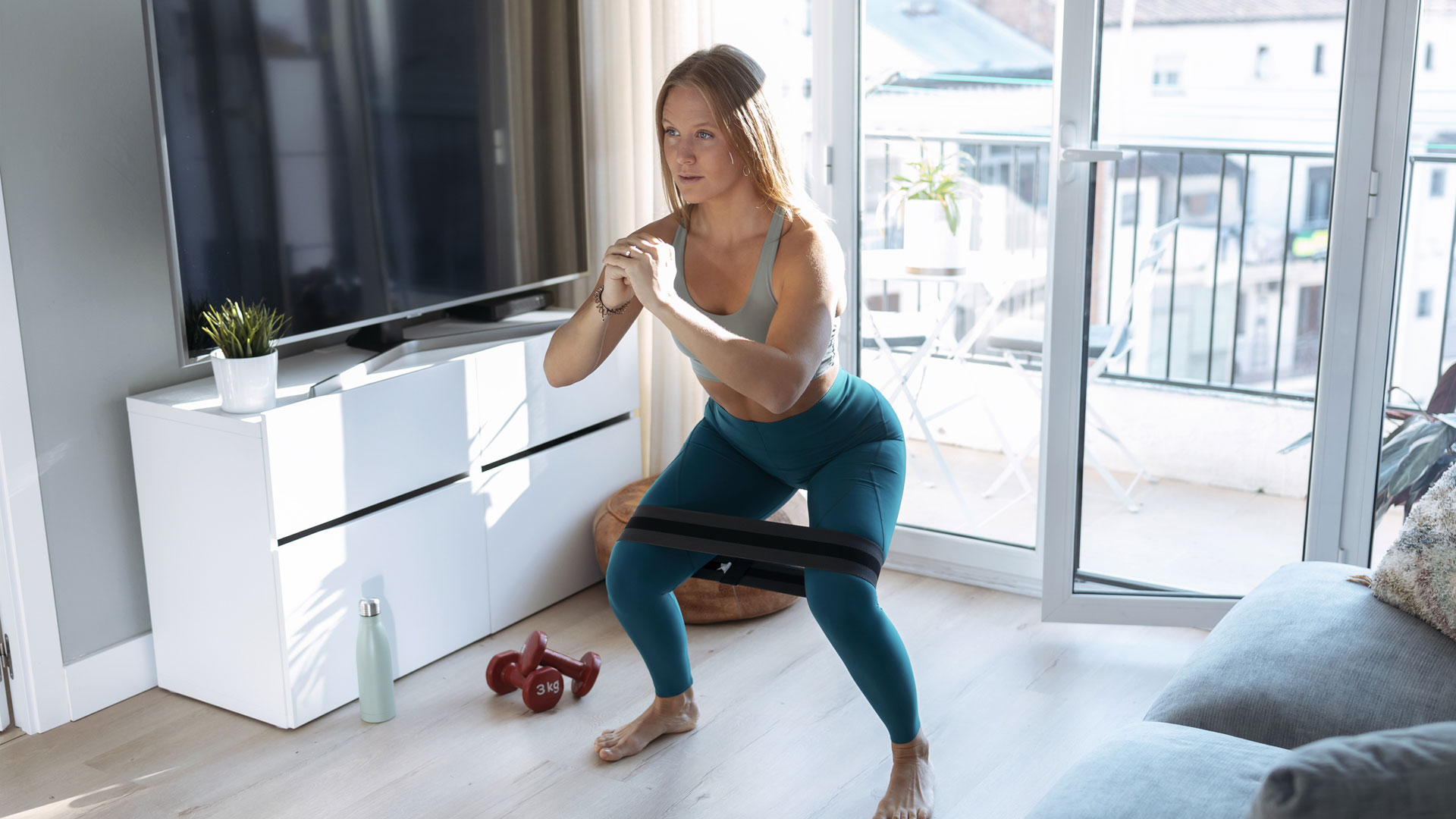3 resistance band workouts that deliver the ultimate burn at home
Skip the weight room next leg day

Want to train your legs? These resistance bands leg workouts will help you build a stronger lower body from just about anywhere. Your leg muscles are some of the biggest in your body and require a lot of blood and oxygen in order for them to work hard. As such, your lungs and heart need will also get a workout on leg day.
Whether you're not yet back in the gym after the pandemic, or you prefer working out from home, using resistance bands is an excellent way to make leg workouts more challenging. Looking for bands to add to your collection? We've hand-picked the best resistance bands for your home workouts here.
What are the benefits of using resistance bands?
Resistance bands are unbelievably useful pieces of home gym equipment. Firstly, they are incredibly good value, especially when compared to other fitness equipment such as dumbbells or kettlebells, which can be relatively expensive. (Find the best adjustable dumbbells for weightlifting at home here).
They’re also lightweight, which means bringing them to the gym, office, park, or even when traveling is much easier. Resistance bands come in a variety of sizes and resistance levels to accommodate a wide range of goals, abilities, needs, and exercises.

The best resistance band leg workouts
Each of these workouts consists of three exercises. Do the prescribed reps on each exercise, and rest for 30 seconds between each exercise. After doing one set of each, take 60-90 seconds rest, and perform the circuit again for a total of three rounds.
Workout 1: Using a small resistance band only
If you only have a small resistance band, then this is the workout for you. You’ll be using the resistance band looped above your knees to work your glutes harder during the exercises.
If you do have a longer band, you can tie it above the knee joint for this workout, although this can be a little fiddly!
Sign up to get the BEST of Tom's Guide direct to your inbox.
Get instant access to breaking news, the hottest reviews, great deals and helpful tips.
Knee-banded squats: 10-20 reps
Squats are a great exercise as they work your entire leg, especially your thighs. Adding the band will give extra work to your glute muscles.
Loop the band around your legs just above your knees, and stand with your feet about shoulder-width apart. Point your toes out slightly. Bend your knees and hips at the same time, and push your knees out against the band so that your knees track directly over your feet.
As you squat down, keep your chest up, and your eyes looking straight forward. Squat as low as you can while pushing your knees out against the band, and stand up to complete the squat.
Clamshells: 10-20 reps per leg
Clamshells focus on the gluteus medius muscle, which is strongly involved in knee position and strength.
Keeping the band around your knees, lie on your left side with your hips bent to around 45 degrees, and your knees bent to 90 degrees. Support yourself using your left arm, and place your right arm on top of your right hip. Keeping your feet together, lift your right knee towards the ceiling to pull the band apart.
Don’t let your right hip move back — the only movement should be you lifting your right knee. Hold for a 1-second count at the top, before lowering your right knee and performing another rep.
Knee-banded hip thrusts: 10 - 20 reps
Hip Thrusts focus all of the attention on the glutes, building a strong posterior, and stretching out the front of your hips.
With the band still around your knees, prop your upper back onto a seat or sofa. Have your feet flat on the floor, hip-width apart, with your knees and hips, bent. Push your knees out against the band, and push through your heels to raise your hips up to the ceiling while keeping your knees pushing outwards. Hold for a 2-second count at the top before returning to the bottom.
Workout 2: Using a long resistance band only
This workout uses a long resistance band to work your leg muscles in a variety of different ways.
Resistance band split squats: 8 - 12 reps per leg
Split squats work one leg at a time, allowing you to really focus on the muscles of that one leg.
Stand with one foot forward on top of the resistance band, and the other foot about 2 feet behind you. Grab each end of the band in your hands, or loop the band around your shoulders for extra resistance. Keeping your torso vertical, bend both knees until your back knee taps the floor, and push through your front foot to stand back up.
Monster walk: 10-15 reps per leg
The monster walk is an excellent exercise to work the muscles at the sides of the hips, and develop good hip strength and knee control.
Stand with both feet on the resistance band, hip-width apart, and the other end of the band in your hands. Cross the band over so it forms an X and hold it around waist height. With good tension in the band, take a step to your right, and bring your left to follow the right, bringing your feet back to hip-width apart.
Resistance band squats: 10 -15 reps
These squats will work the entire leg, especially your thigh muscles, and the resistance band will make it tougher as you stand up.
Stand on the band like the previous exercise, and loop the other end around your shoulders. Stand with your feet about shoulder-width apart, and toes pointing out slightly. Bend your knees and hips at the same time, and push your knees out so that your knees track directly over your feet. As you squat down, keep your chest up, and your eyes looking straight forward. Squat as low as you can and stand up to complete the squat.
Workout 3: Using both big and small resistance bands
This workout is for those fortunate enough to have long and small bands at their disposal, and is a truly total-leg workout.
Resistance band deadlift: 10 -15 reps
The deadlift is a hip-focused exercise, working the back of the thighs and glutes, and strengthening the back.
Lay the band flat on the floor, stand on it with feet hip-width apart, and grab the ends in either hand, like you’re carrying groceries. Lean over as far as you can, keep your shins roughly vertical, your back flat, and stand up while holding onto the band. Perform each deadlift in a slow, controlled movement, and once you’re standing tall at the top of the movement, return to the starting position by bending at the hips.
Here's more information on how to do a resistance band deadlift and the different variations to try.
Banded kickbacks: 10 - 20 reps per leg
Kickbacks totally isolate the glutes for an awesome burn, as you can focus on working one leg at a time.
Stand with a small band around your ankles. Grab hold of a door, banister, or countertop for support. Stand on your right leg, and pick your left foot off the floor. Kick your left leg straight back as far as you can go without arching your back. Control your left leg back to the starting position, and go for another rep.
Resistance band narrow squats: 10 - 15 reps
This squat variation will push the focus towards the muscles at the front of your thighs, and should really burn after the deadlifts and kickbacks!
Stand on the band with your feet hip-width apart, toes pointing straight forward and loop the other end of the band around your shoulders. Bend your knees and hips at the same time, like you’re sitting on a chair that’s directly beneath you, and keep your knees in line with your toes. As you squat down, keep your chest up, and your eyes looking straight forward. Squat as low as you can while pushing up against the band, and simply stand up to complete the squat.
Looking for more workout inspiration? We've found the best resistance band exercises for building your arms, the best ab workouts you can do for free, an exercise that’s better than squats at building your glutes, and one of the best ab exercises when it comes to sculpting a slimmer waistline.
Will McAuley is a London-based Personal Trainer and Nutrition Coach who’s writing has appeared in Men’s Fitness and GQ magazine, covering exercise, nutrition and health. He has a Master’s degree in Strength & Conditioning from Middlesex University in London, is a published scientific author in the Journal of Strength and Conditioning Research, and holds a Bachelor’s degree in Linguistics from Trinity College Dublin.






